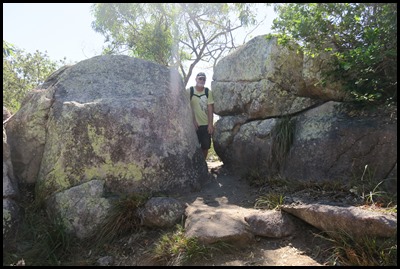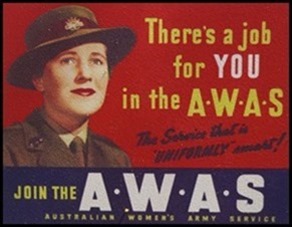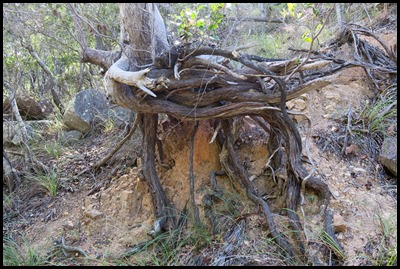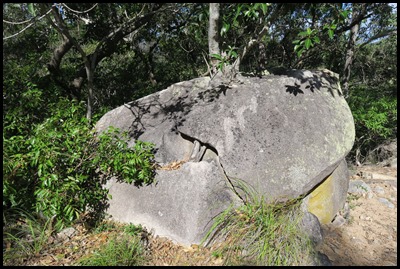MI Forts Walk Pt 2

Beez Neez now Chy Whella
Big Bear and Pepe Millard
Wed 15 Jun 2016 22:47
|
The Forts Walk on Magnetic Island – Part
Two
 Up the next set of steps and we found
the sign, going left
first.
  Up some more steps the track looked
like it came to a dead end, but through a little gap we saw a metal
staircase.
 The Command Post. The space between boulder and building was where the commanding
officer slept on a bunk between
watches.
  Inside.
   Women’s
work. The disguise taken from a seaweed decorator crab and other
creatures.
“Our job was to work with the Navy
in identification of ships in Cleveland Bay. The Navy would signal the ship for
the signal of the day and then tell them to either proceed or stop,” CO
Major Arnold Nicolle.
The artillery command post controlled
all battery operations, including searchlights and radar units. It housed the
main depression range finder, a long telescope on finely geared mountings seated
on the concrete column, used to measure the exact range to a target. The
Australian Women’s Army Service plotters used the readings to calculate details
for the guns and communicated orders to the battery command on Castle Hill in
Townsville.
The boxy building looked very different in
the war, concealed by a cloak of decorated netting and concrete rocks to blend
into the natural environment. “Camouflage is the art of concealing the fact
that you are concealing.” Guy Hartcup. Camouflage: a history of
concealment and deception in war.
During World War II, artists, photographers and scientists
joined forces to develop innovative three-dimensional camouflage methods to
‘fool the aerial eye’. Better known for his research on Australian sea life than
for his 1941 publication Art of Camouflage, late Sydney zoologist
William Dakin used his knowledge of cryptic marine animals to research
camouflage techniques possibly used here.
 Back through the gap in the
rocks.
  Up the final set of steps to the
Signal Station 233 metres above sea level.
 From the viewing platform we could look back to the
Command Post.
    The views. We
enjoyed them for several minutes then back down the track we went.
   For some unknown reason we didn’t divert off the track
at the first sign on our way, so we missed the women’s
latrine sign and carried on to the Forts. Knowing we would just see a concrete base, Bear stayed on the track and I nipped off
for the information board, so pleased I did.
   Here at the women’s latrine and ablution block, the service
women had time to themselves, away from the rest of the camp, to freshen up
after duty before retiring to the nearby sleeping hut. From 1941, single women
aged between 18 and 45 years were encouraged to join the Australian Women’s Army Service (AWAS) to release men –
maybe their loved ones – for the distant front line. Women’s work included store
keeping, driving, searchlight spotting and signalling. It’s thought that about
12 AWAS signallers held positions here from mid-1943. Off-duty, a young woman may have peered in a mirror here
wishing for lipstick while pinning her hair and buttoning up a clean uniform in
readiness for a dance at the Arcadia Guesthouse. We can just imagine the chatter after an evening
spent with attentive US Army servicemen...... I just had to call Bear
waiting on the track – of all the names to see on the information board. Well done
Bonnie, a fine age.
  Bimbling back down the track gave us new views, high rocky outcrops ahead.
  This tree was worth a stop, most of the
roots mid-air.
  Most impressive was this tree that had
literally punched its way through a rock. On we went popping out at the
car park, down the main road to reach Koala Village for the two thirty
tour.
 Final pose before bimbling down the
hill.
ALL IN ALL A GOOD WALK WITH LOTS TO SEE REALLY INTERESTING WITH FABULOUS VIEWS |